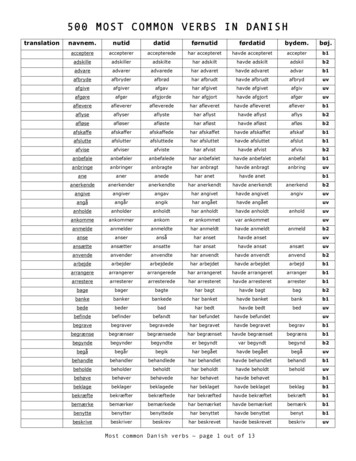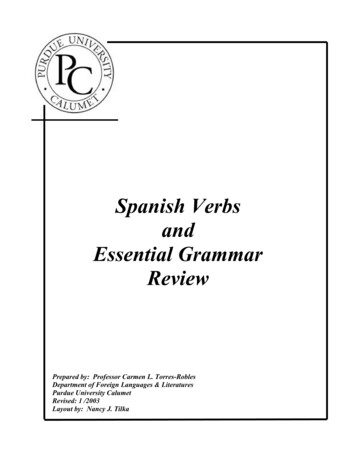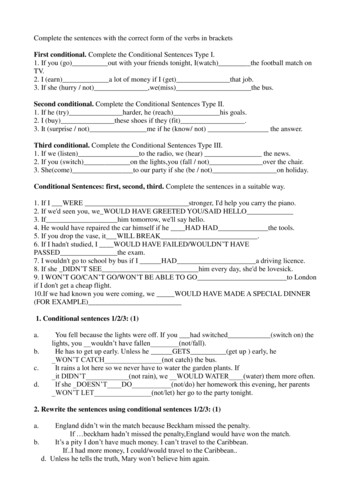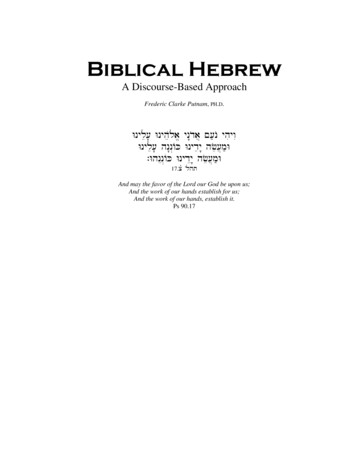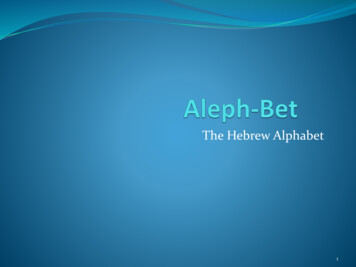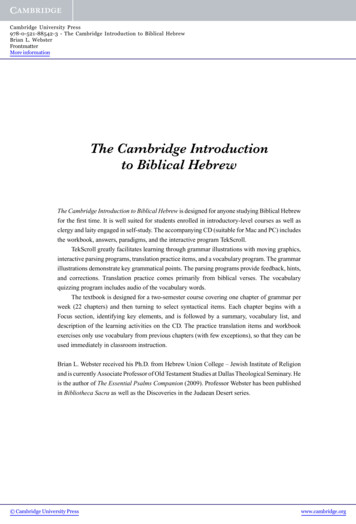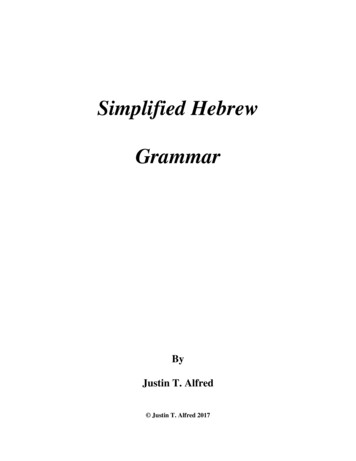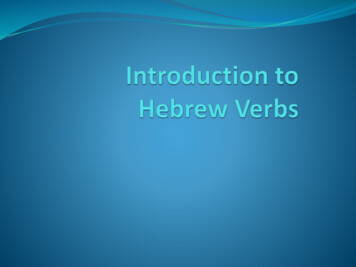
Transcription
Introduction to Hebrew Verbs Some parts of this presentation will repeat what wascovered in the Overview of Biblical Hebrewpresentation.
Introduction to Hebrew Verbs Verbs are composed of a 3-consonantal root called ashoresh. Each letter of the root is numbered (right to left): III – II – I These become important when identifying weak verbs;these usually involve guttural letters ( א , ה , ח , ע , )ר inone of these 3 positions. Depending on the form of the verb, prefixes and/orsuffixes are added to identify the person doing theaction of the verb.3
Introduction to Hebrew Verbs Hebrew grammars use either qatal ( קָטַל to kill) orpaqad ( פָקַד to visit) as their paradigm verb forstrong verbs to show the various prefixes and suffixesthat can be attached to a shoresh (root). These verbs are called strong verbs because they donot contain any guttural letters ( א , ה , ח , ע , )ר andthey change predictably throughout the paradigm.4
Introduction to Hebrew Verbs Examples of Strong and Weak Verbs פקַד ְָ הָלַך ְג ָאַל שלַח ָIII II IIII II IIII II IIII II IStrongVISIT1st – HehGO, WALK2nd – GutturalREDEEM3rd – GutturalSEND
Introduction to Hebrew Verbs Before I give a general overview of the verb stems(binyanim), we need to understand what active, passive,and reflexive is. Active when the subject is doing the action. The boy (subject) hit the ball. Passive when the subject is receiving the action. The boy (subject) was hit by the ball. Reflexive when the subject does something tohimself. The boy (subject) hit himself with the ball.6
Introduction to Hebrew Verbs The 7 major (most common) binyanim are: Qal active voice, simple basic action Niphal passive voice, simple basic action Piel active voice, intensive action Pual passive voice, intensive action Hitpael reflexive voice, intensive action Hiphil active voice, causal action Hophal passive voice, causal action The vast majority of the verbs in Scripture are Qal. (Note: Slight spelling differences in the binyanim may be seen in variousgrammars.)7
Introduction to Hebrew Verbs Each binyan has a range of uses: Qal – action or state Niphal – passive, reflexive, reciprocal Piel – acting strongly, factitive/resultative, urgingothers, doing an action related to a noun Hiphil – causing, doing, being, declaring Hitpael – doing to/for oneself; doingtogether/reciprocally; doing repetitively or continually;acting or pretending
Introduction to Hebrew Verbs You may see a few more binyanim mentioned in yourlexicon or grammar that are considered to be minor: These are used with bi-consonantal and geminate(twin) roots. Polel – same meaning as Piel (active voice, intensiveaction) Polal – same meaning as Pual (passive voice, intensiveaction) Hitpolel – same meaning as Hitpael (reflexive voice,intensive action).9
Introduction to Hebrew VerbsBinyanimBinyan (Stem)3ms Perfect קָל Qal נ ִפעַל Niphal פעֵל ִPiel פעַל ֻּPualַ הִת Hitpael פעֵל הִפעִיל Hiphil הָפעַל Hophal קָטַל Qamets under 1st root letter ְנ ִקטַל Prefixed ִ ְנ קִטֵל Dagesh in 2nd strong root letter קֻּטַל Kibbuts under 1st root letterNote: הִתקַטֵל Prefixed הִת הִקטִיל Prefixed ִ י ; ה in 3rd person הָקטַל Prefixed ָ ( ה qamets hatuph) קָטַל is our paradigm verb meaning To kill. It is also called the perfect verb form.
Introduction to Hebrew VerbsBinyanimBinyan (Stem)3ms Imperfect קָל Qal נ ִפעַל Niphal פעֵל ִPiel פעַל ֻּPualַ הִת Hitpael פעֵל הִפעִיל Hiphil ְי ִקטֹל Hophal הָפעַל Note: קטֵל ָ ִ ְי נ assimilated as dagesh in 2nd root letter טל ֵ ַ ְיק Dagesh in 2nd strong root letter ְיקֻּטַל Kibbuts under 1st root letter ְי ִתקַטֵל Only ת remains from the הִת ְי ַקטִיל Prefixed ִ ה gone; י between 2nd and 3rd rootletter in all forms but 2fp & 3fp ְי ָקטַל Prefixed ָ ( ה qamets hatuph) קָטַל is our paradigm verb meaning To kill. It is also called the perfect verb form.
Introduction to Hebrew Verbs Different verbal stems [binyan (sg) or binyanim (pl)]are formed with a 3-consonantal root (shoresh) by: Changing the vowel points; Sometimes by adding a dot called a dagesh; Sometimes by adding a prefix. Be aware that some verbs have bi-consonantal roots.12
Introduction to Hebrew VerbsQal3rd Person, Masc.Sing. Perfect קָטַל 3rd Person, Masc.Sing. Imperfect ְי ִקטֹל NiphalPielPual ְנ ִקטַל קִטֵל קֻּטַל קטֵל ָ ִ ְי ְיקַטֵל ְיקֻּטַל HitpaelHiphil הִתקַטֵל הִקטִיל י ִתקַטֵל ְי ַקטִיל Hophal הָקטַל ְי ָקטַל BinyanNotice the addition of prefixes, dageshes, and variation in vowel pointings of theperfect and imperfect forms between binyamin.13
Introduction to Hebrew Verbs Verbal stems (binyanim) affect a root’s meaning; notits function within a discourse. If your lexicon gives you meanings for a verb’s variousbinyanim, you must consider only the definitions forthe specific binyan in the verse you are looking at. These are seen in BDB (or Gesenius) but not inStrong’s.14
Introduction to Hebrew Verbs15
Introduction to Hebrew Verbs Hebrew verbs do not always exist in every possiblebinyan. Not every binyan has an attested form of every person,number, and gender (PNG) in Scripture. The 3rd person, masculine, singular, qal perfect is thelexical form of a verb whether or not the qal binyaneven exists for that verb.16
Introduction to Hebrew Verbs Weak verbs have one or more guttural letters in theirroot but their vowels do not always change exactly thesame as strong verbs throughout the paradigm. Other verbs have missing root letters or are bi-consonantal. These and weak verbs have their own paradigm lists.17
Introduction to Hebrew Verbs In Scripture, verbs appear in different forms. Verbalparadigms exist for the binyanim in these forms: Perfect [also known as qatal ( )קָטַל or suffix conjugation] Imperfect [also known as yiqtol ( )י ִקטֹל or prefix conjugation] Participles [active and/or passive depending on the binyan] Infinitives [construct and absolute] Volitionals [Jussives (3p), Imperatives (2p), Cohortatives (1p)] Preterite All of these will eventually be covered in future presentations. Begin focusing on the Perfect and Imperfect forms for now.18
Introduction to Hebrew Verbs3ms3fs2ms2fs1cs קָטַל ק ָֽטלָה ָָ קָטַַ֫לת קָטַלת קָטַַ֫לתִי Qal Perfect (Qatal)ka-tal ק ָֽטל ְו ָ3cpka-te-laka-tal-ta 2mp קטַלתֶּם ka-talt קטַלתֶּן 2fpka-tal-tee 1cp קָטַַ֫לנ ְו ka-te-looka-tal-temka-tal-tenka-tal-nooThe suffixes of a perfect verb identify the person of the verb which must agree innumber and gender with the accompanying noun or pronoun.M memorize this chart19
Introduction to Hebrew Verbs The Perfect (Qatal) Verb can be used to describecompleted or definite action. These can be translatedas: Past tense; Past/Present/Future Perfect Tense Not all verbs describe action; a state of being can betranslated as: Past or present tense. Verbs of perception or attitude can be translated: Present tense.20
Introduction to Hebrew Verbs Qatal is the verb form used to begin a historicalnarrative. Translated as a simple past tense Qatal is also used in combination with a relativepronoun to form dependent clauses. It can betranslated as a: past perfect (had ) present perfect (have/has )
Introduction to Hebrew Verbs3ms3fs2ms2fs1csQal Imperfect (Yiqtol)yik-tol 3mp ְי ִקטֹל ְי ִקטל ְו 3fptik-tol תִקטֹל תִקטַֹ֫ל ְנ ָה 2mptik-tol תִקטֹל תִקטל ְו תִקטלִי tik-te-lee 2fp תִקטַֹ֫ל ְנ ָה 1cpek-tol אֶּקטֹל ְנ ִקטֹל yik-te-lootik-tol-natik-te-lootik-tol-nanik-tolThe prefixes and suffixes of a verb identify the person of the imperfect verb whichmust agree in number and gender with the accompanying noun or pronoun.M22
Introduction to Hebrew Verbs The imperfect (yiqtol) verb describes past, present, orfuture incomplete or continued action. It can betranslated as: Present tense Future tense If used this way, it will usually not be the first word inits clause. If it is the first word in a clause, this is usually avolitional verb (Jussive, Cohortative).23
Introduction to Hebrew Verbs Don’t worry too much about memorizing the tense ofverbs based on this information at this point. I’m just trying to introduce you to various terminologyand lay a foundation for future learning.
Introduction to Hebrew Verbs Try to memorize the strong verb paradigm tables for all thebinyamin starting with the qal (most basic form). Eventually you can work on becoming familiar with thevowel differences seen in the paradigms of weak verbs. Realize you will always be using a computer or tables toidentify forms you don’t know. This is normal. The more you practice reading Hebrew, the easier it will beto naturally pick up on these things.
Introduction to Hebrew Verbs Obviously, there are different ways to approach thetranslation of Hebrew verb tense. Personally, I think it’s easier to learn how to translate verbtense based on the genre of the discourse. The key is in learning the discourse profile schemes throughrepetition and seeing examples. We will look at lots of examples from Scripture in futurepresentations. Before we can do that, we’ll need to learn a few more terms.
Introduction to Hebrew Verbs One verb form we need to know is: Wayyiqtol (pronounced va-yiqtol, spelled ) ְוי ִקטֹל .Hebrew grammars may call it: Converted imperfectImperfect with Vav consecutiveFuture with Waw conversiveFuturewaPC It’s basically a vav imperfect verb. It is the primary verb form seen in historical narrative.27
Overview of Biblical Hebrew Another verb form is weqatal (pronounced ve-qatal,spelled ְוקָטַל . It’s basically a vav perfect verb. It is seen in predictive narratives, procedural discourses(which describe repetitive or customary behavior), andfor isolated pivotal events. The tense of the weqatal is translated differently (past orfuture tense) depending on the genre and purpose of thetext.28
Introduction to Hebrew Verbs When a vav is prefixed to a yiqtol (imperfect) verbform, it always reverses or converts the verb to theopposite tense. Hence the name vav-conversive. (Remember, it’s alsoknown as a vav-consecutive.) Yiqtol – usually present or future tense Wayyiqtol – past tense in historical narrative.
Introduction to Hebrew Verbs When the Vav is prefixed to the qatal (perfect) verb form, it often (butnot always) reverses or converts the verb to the opposite tense. When it does convert the tense of the verb, it is a vav-conversive (vav-consecutive). When it doesn’t, it is vav-conjunctive (or conjunctive vav). This is the case for procedural discourse (customary behavior) andisolated pivotal events. Qatal – usually past perfect, or present perfect tense in dependentclauses; or past tense Weqatal – past, present, or future tense depending on the genre.
Overview of Biblical Hebrew Mainline verb forms move the Biblical Narrative forward. Historical Narrative: Wayyiqtol; Weqatal in procedural discourse; or isolated Weqatal inpivotal/climatic events Predictive Narrative and Instructional Discourse: Weqatal; or occasional imperative Hortatory Discourse (influence someone’s behavior): Volitionals [Jussive(3rd), Imperative (2nd), Cohortative (1st)] Weqatals – for Mitigated (less intense) Hortatory Discourse31
Introduction to Hebrew Verbs Off-line verb forms slow down the movement of theBiblical Narrative. Here’s a limited list: X-qatal Shifts focus (subject precedes verb) Relative background information Qatal - PastYiqtol - Non-pastDependent (relative) clausesbegin with שר ֶּ ֲ א , אִם , כִי , etc. Participles - Gives background activities Mainline form of היה makes transitions ל ֹא negates any verb32
Introduction to Hebrew Verbs As you can see, verb forms, not verbal stems (binyanim),have special discourse functions. In English, verb tense such as past, present, and future isrepresented by their own specific verb forms. In Hebrew, verb tense is not determined just by verb forms;it is also a function of the genre of the discourse. See Rocine for full details on discourse profile schemes.33
Introduction to Hebrew Verbs In the next presentation we will look at examples ofthe use of some of the things we have been discussing.
Introduction to Hebrew Verbs Biblical Hebrew A Compact Guide, Miles Van Pelt,Zondervan, Grand Rapids, Michigan, copyright 2012. Biblical Hebrew An Introductory Grammar, PageH. Kelly, William B. Eerdmans Publishing Company,Grand Rapids, Michigan, copyright 1992. Learn Biblical Hebrew, 2nd Edition, with Audio CDRom, John H. Dobson, Piquant Editions, Ltd., Carlisle,CA3 9GR, United Kingdom. Learning Biblical Hebrew A New Approach UsingDiscourse Analysis, B.M. Rocine, Smyth & HelwysPublishing, Inc., Macon, Georgia, copyright 2000.35
Hebrew lessons compiled by: Beth C. Mehaffeyhttps://holyhiway.wordpress.comContact: betmeh2 at gmail.com36
Introduction to Hebrew Verbs Obviously, there are different ways to approach the translation of Hebrew verb tense. Personally, I think it’s easier to learn how to translate verb tense based on the genre of the discourse. The key is in learning the discourse



